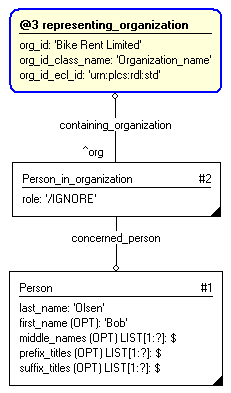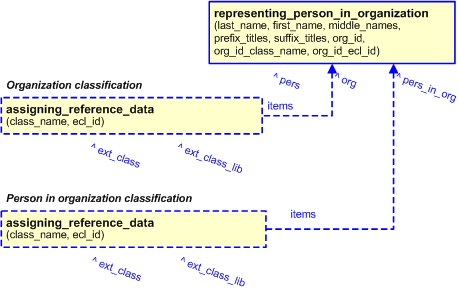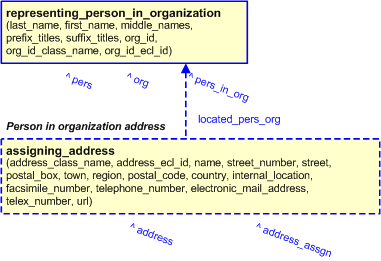| Template:— representing_person_in_organization (rep_pers_org) |
Date: 2008/02/26 15:26:31
Revision: 1.15
|
This section specifies the template representing_person_in_organization.
NOTE
An explanation of a template and the associated instantiation path is
provided in the
Template overview
section.
This template describes the representation of a person to an organization
independent of other entities in order to be referenced from other templates.
The EXPRESS-G diagram in
Figure
1
shows the templates and EXPRESS entities that are required
to represent the template
"representing_person_in_organization".
The text highlighted in blue shows the template parameters.
Figure 1 — An EXPRESS-G representation of the Information model for representing_person_organization
The graphic for the template to be used in other EXPRESS-G diagrams
is shown in Figure
2
below.
Figure 2 — The graphical representation of the representing_person_organization template
The following input parameters are defined for this template:
The last name (surname) of the person.
first_name (Default=/NULL,Type='STRING', Optional)
The first element of the Person's list of forenames. This parameter is optional.
The Person's other forenames.
The text that specifies the Person's social or professional standing
and appear before his or her names. This parameter is optional.
The text that specifies the Person's social or professional standing
and appear after his or her names. This parameter is optional.
The identifier or name of the organization.
The following classes and their sub-classes can be used:
The identifier of the
External_class_library
storing the definition of the class referenced by the parameter @org_id_class_name class.
The following reference parameters are defined for this template:
Allow the
Person
entity instantiated in this path to be referenced when this template is used.
Note: The
Person
entity can be referenced in a template path by:
%^target = $representing_person_in_organization.pers%
where
target
is the parameter to which the
Person
is bound.
Allow the
Organization
entity instantiated in this path to be referenced when this template is used.
Note: The
Organization
entity can be referenced in a template path by:
%^target = $representing_person_in_organization.org%
where
target
is the parameter to which the
Organization
is bound.
Allow the
Person_in_organization
entity instantiated in this path to be referenced when this template is used.
%^target = $representing_person_in_organization.pers_in_org%
The following parameter combinations specify a uniqueness constraint:
Unique constraint: Unique person in organization
The instantiation path shown below specifies the entities that are to be
instantiated by the template.
The following entities are instantiated with attributes as specified:
The instance diagram in Figure
3
shows an example of the EXPRESS entities and templates that are instantiated by the template:
@12 /representing_person_in_organization(last_name='Olsen', first_name='Bob', middle_names='$', prefix_titles='$', suffix_titles='$', org_id='Bike Rent Limited', org_id_class_name='Organization_name', org_id_ecl_id='urn:plcs:rdl:std')/
(an illustration of the consolidated representing_person_in_organization template is shown in
Figure
4 below.)
Note that the template
representing_organization is used in the diagram:
@3 /representing_organization(id='Bike Hire Limited', id_class_name='Organization_name', id_ecl_id='urn:plcs:rdl:std')/
Figure 3 — Entities instantiated by representing_person_in_organization template
The instance diagram in
Figure
4
shows the graphic symbol for the template that is to be
used in other instance diagrams. The example template is:
@12 /representing_person_in_organization(last_name='Olsen', first_name='Bob', middle_names='$', prefix_titles='$', suffix_titles='$', org_id='Bike Rent Limited', org_id_class_name='Organization_name', org_id_ecl_id='urn:plcs:rdl:std')/
Figure 4 — Instantiation of representing_person_in_organization template
The following section details how the
representing_person_in_organization
template can be optionally characterized by assigning
other constructs to it. These are characterizations commonly
applied to the template. The ISO 10303-239 EXPRESS model may enable
other assignments to the entities instantiated by the template.
The following characterizations may apply:
Characterization Assigning identification
NOTE this characterization is optional.
Characterization Assigning classifications
NOTE this characterization is optional.
Characterization Assigning address
NOTE this characterization is optional.







